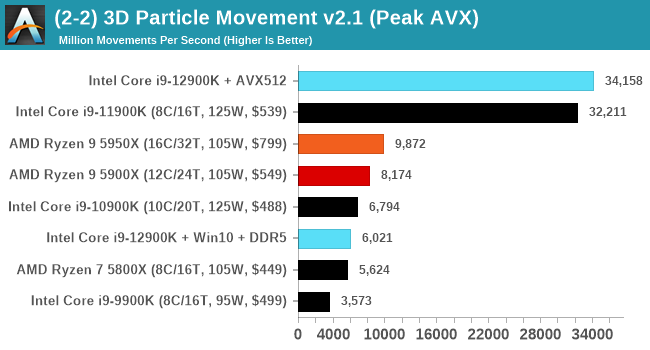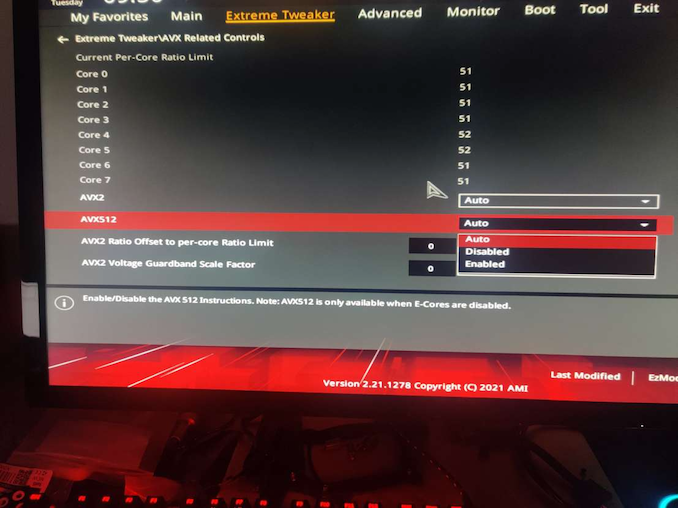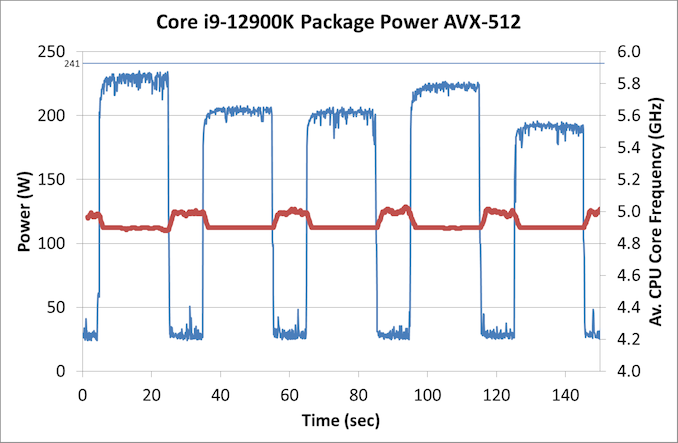The Intel 12th Gen Core i9-12900K Review: Hybrid Performance Brings Hybrid Complexity
by Dr. Ian Cutress & Andrei Frumusanu on November 4, 2021 9:00 AM ESTIntel Disabled AVX-512, but Not Really
One of the more interesting disclosures about Alder Lake earlier this year is that the processor would not have Intel’s latest 512-bit vector extensions, AVX-512, despite the company making a big song and dance about how it was working with software developers to optimize for it, why it was in their laptop chips, and how no transistor should be left behind. One of the issues was that the processor, inside the silicon, actually did have the AVX-512 unit there. We were told as part of the extra Architecture Day Q&A that it would be fused off, and the plan was for all Alder Lake CPUs to have it fused off.
Part of the issue of AVX-512 support on Alder Lake was that only the P-cores have the feature in the design, and the E-cores do not. One of the downsides of most operating system design is that when a new program starts, there’s no way to accurately determine which core it will be placed on, or if the code will take a path that includes AVX-512. So if, naively, AVX-512 code was run on a processor that did not understand it, like an E-core, it would cause a critical error, which could cause the system to crash. Experts in the area have pointed out that technically the chip could be designed to catch the error and hand off the thread to the right core, but Intel hasn’t done this here as it adds complexity. By disabling AVX-512 in Alder Lake, it means that both the P-cores and the E-cores have a unified common instruction set, and they can both run all software supported on either.
There was a thought that if Intel were to release a version of Alder Lake with P-cores only, or if a system had all the E-cores disabled, there might be an option to have AVX-512. Intel shot down that concept almost immediately, saying very succinctly that no Alder Lake CPU would support AVX-512.
Nonetheless, we test to see if it is actually fused off.
On my first system, the MSI motherboard, I could easily disable the E-cores. That was no problem, just adjust the BIOS to zero E-cores. However this wasn’t sufficient, as AVX-512 was still clearly not detected.
On a second system, an ASUS motherboard, there was some funny option in the BIOS.
Well I’ll be a monkey’s uncle. There’s an option, right there, front and centre for AVX-512. So we disable the E-cores and enable this option. We have AVX-512 support.
For those that have some insight into AVX-512 might be aware that there are a couple of dozen different versions/add-ons of AVX-512. We confirmed that the P-cores in Alder Lake have:
- AVX512-F / F_X64
- AVX512-DQ / DQ_X64
- AVX512-CD
- AVX512-BW / BW_X64
- AVX512-VL / VLBW / VLDQ / VL_IFMA / VL_VBMI / VL_VNNI
- AVX512_VNNI
- AVX512_VBMI / VBMI2
- AVX512_IFMA
- AVX512_BITALG
- AVX512_VAES
- AVX512_VPCLMULQDQ
- AVX512_GFNI
- AVX512_BF16
- AVX512_VP2INTERSECT
- AVX512_FP16
This is, essentially, the full Sapphire Rapids AVX-512 support. That makes sense, given that this is the same core that’s meant to be in Sapphire Rapids (albeit with cache changes). The core also supports dual AVX-512 ports, as we’re detecting a throughput of 2 per cycle on 512-bit add/subtracts.
For performance, I’m using our trusty 3DPMAVX benchmark here, and compared to the previous generation Rocket Lake (which did have AVX-512), the score increases by a few percent in a scenario which isn’t DRAM limited.

Now back in that Rocket Lake review, we noted that the highest power consumption observed for the chip was during AVX-512 operation. At that time, our testing showcased a big +50W jump between AVX2 and AVX-512 workloads. This time around however, Intel has managed to adjust the power requirements for AVX-512, and in our testing they were very reasonable:
In this graph, we’re showing each of the 3DPM algorithms running for 20 seconds, then idling for 10 seconds. Each one has a different intensity of AVX-512, hence why the power is up and down. IN each instance, the CPU used an all-core turbo frequency of 4.9 GHz, in line with non-AVX code, and our peak power observed is actually 233 W, well below the 241 W rated for processor turbo.
Why?
So the question then refocuses back on Intel. Why was AVX-512 support for Alder Lake dropped, and why were we told that it is fused off, when clearly it isn’t?
Based on a variety of conversations with individuals I won’t name, it appears that the plan to have AVX-512 in Alder Lake was there from the beginning. It was working on early silicon, even as far as ES1/ES2 silicon, and was enabled in the firmware. Then for whatever reason, someone decided to remove that support from Intel’s Plan of Record (POR, the features list of the product).
By removing it from the POR, this means that the feature did not have to be validated for retail, which partly speeds up the binning and testing/validation process. As far as I understand it, the engineers working on the feature were livid. While all their hard work would be put to use on Sapphire Rapids, it still meant that Alder Lake would drop the feature and those that wanted to prepare for Alder Lake would have to remain on simulated support. Not only that, as we’ve seen since Architecture Day, it’s been a bit of a marketing headache. Whoever initiated that dropped support clearly didn’t think of how that messaging was going to down, or how they were going to spin it into a positive. For the record, removing support isn’t a positive, especially given how much hullaballoo it seems to have caused.
We’ve done some extensive research on what Intel has done in order to ‘disable’ AVX-512. It looks like that in the base firmware that Intel creates, there is an option to enable/disable the unit, as there probably is for a lot of other features. Intel then hands this base firmware to the vendors and they adjust it how they wish. As far as we understand, when the decision to drop AVX-512 from the POR was made, the option to enable/disable AVX-512 was obfuscated in the base firmware. The idea is that the motherboard vendors wouldn’t be able to change the option unless they specifically knew how to – the standard hook to change that option was gone.
However, some motherboard vendors have figured it out. In our discoveries, we have learned that this works on ASUS, GIGABYTE, and ASRock motherboards, however MSI motherboards do not have this option. It’s worth noting that all the motherboard vendors likely designed all of their boards on the premise that AVX-512 and its high current draw needs would be there, so when Intel cut it, it meant perhaps that some boards were over-engineered with a higher cost than needed. I bet a few weren’t happy.
Update: MSI reached out to me and have said they will have this feature in BIOS versions 1.11 and above. Some boards already have the BIOS available, the rest will follow shortly.
But AVX-512 is enabled, and we are now in a state of limbo on this. Clearly the unit isn’t fused off, it’s just been hidden. Some engineers are annoyed, but other smart engineers at the motherboard vendors figured it out. So what does Intel do from here?
First, Intel could put the hammer down and execute a scorched earth policy. Completely strip out the firmware for AVX-512, and dictate that future BIOS/UEFI releases on all motherboards going forward cannot have this option, lest the motherboard manufacturer face some sort of wrath / decrease in marketing discretionary funds / support. Any future CPUs coming out of the factory would actually have the unit fused out, rather than simply turned off.
Second, Intel could lift the lid, acknowledge that someone made an error, and state that they’re prepared to properly support it in future consumer chips with proper validation when in a P-core only mode. This includes the upcoming P-core only chips next year.
Third, treat it like overclocking. It is what it is, your mileage may vary, no guarantee of performance consistency, and any errata generated will not be fixed in future revisions.
As I’ve mentioned, apparently this decision didn’t go down to well. I’m still trying to find the name of the person/people who made this decision, and get their side of the story as to technically why this decision was made. We were told that ‘No Transistor Left Behind’, except these ones in that person’s mind, clearly.












474 Comments
View All Comments
web2dot0 - Thursday, November 4, 2021 - link
Who in their right mind thinks Intel is moving in the right direction?250W TDP?!?!?
Apple came out with their 30W TDP that can rival desktop CPU parts.
Comically embarrassing.
geoxile - Thursday, November 4, 2021 - link
Apple rivals desktop CPUs in SPECINT, which clearly loves memory bandwidth and cache. DDR5 alone boosted ADL's score in SPECINT MT by 33% from a DDR4 configuration. In Cinebench and geekbench the m1 pro and max are closer to workstation laptop processors. We'll see what happens with ADL mobile.Ppietra - Thursday, November 4, 2021 - link
The 12600K has basically the same Geekbench score of the M1 Max, and yet its 10 cores consume 3 times more than the M1.On the 12900K just using the 8 E-cores consumes more than the M1 Max using the CPU at peak power. So we shouldn’t expect big miracles in mobile, unless Intel starts selling 90W chips.
As for Cinebench, it will be difficult for Apple Silicon to come out on top until Apple implements some sort of Hyperthreading, Cinebench takes good advantage from it.
geoxile - Thursday, November 4, 2021 - link
The H55 segment will offer 8+8 at 45W and H45 will offer 6+8 at 35W, no need to compare the 12600k. We have models for how mobile uses power compared to desktop. They retain 80-90% of the performance at 1/3 to 1/4 the sustained power. 5900HS @ 35W cTDP (35-40W actual power) has around 85% the performance of the 5800X @110-120W in cinebench. The 11980HK at 45W has almost 90% the performance of the 11700k at 130-150W (non-AVX) in geekbench 5.Ppietra - Thursday, November 4, 2021 - link
Closer to 15% drop in Geekbench, and probably at much higher package peak power draw than 45W, considering what Anandtech has measured for the 11980HK in Multithreaded tasks (around 75W).geoxile - Thursday, November 4, 2021 - link
The 11980HK respects the configured PL/cTDP for the most part. It only hits 75W during the initial cold start. It uses 65W sustained power when configured to PL 65 and 45W when configured to 45Whttps://www.anandtech.com/show/16680/tiger-lake-h-...
I screwed up using tom's results for geekbench, apparently it is at PL 65 unlike Anand's for the TGL test system. But it also scores 9254 vs anandtech's 11700k scoring 9853, so within around 94% performance of its desktop counterpart. I've seen some higher scores on GB itself but using "official" sources that's pretty close to 2x more efficient. I can't seem to find any real PL 45 results for GB5. Point is, scaling down isn't a problem, and ADL will no doubt scale down better thanks to E-cores and just overall better efficiency based on what we've already seen, like gaming efficiency according to igorslab and PL 150 making barely any difference in performance compared to PL 220. I think Intel is in a unique position since AMD doesn't have small cores anymore.
Ppietra - Friday, November 5, 2021 - link
What you are failing to realize is that Geekbench, due to its short tests nature, ends up spending a lot of time at peak performance and not at sustained performance.And no, the 11700k doesn’t score 9853 - you are looking at averages on the Geekbench site which are not reliable to make this sort of comparison. Notebookcheck geekbench score is close to 11300, while the 11980HK scores closer to 9700.
geoxile - Friday, November 5, 2021 - link
Geekbench runs for a few minutes afaik. The peak you're describing only lasts for a split second and quickly falls down to the sustained power over a few seconds to 30 seconds. And no, I'm not looking at averages from geekbench, I literally told you I'm using anand's score for the 11700k and tom's score for TGL mobile. https://www.anandtech.com/bench/CPU-2020/2972Ppietra - Friday, November 5, 2021 - link
geoxile, Geekbench is a bunch of discreet tests with pauses in between.The value that you used is almost exactly the average in the Geekbench database, and we know that the 11700 gets much higher than that. You can also check that Anandtech never showed Geekbench results with that CPU in any of its reviews of the 11700. Don’t know why that value is there.
geoxile - Friday, November 5, 2021 - link
Describing a context switch to load the next bench as "pauses" is borderline gaslighting. It's a memory workload, not idling. PL2 on the 11980HK lasts for seconds from cold start at PL1 45.It's almost or it's exact. Anandtech lists those scores and I have no reason to doubt they copied them or made them up. Tom's has slightly higher scores at 10253 @ stock. That's a 4% variance, probably due to tom's using DDR4 3600 with tuned timings while anandtech used DDR4 3200. It's only with a 5Ghz OC toms can even break through 11000, let alone score 11300.
https://www.tomshardware.com/reviews/intel-core-i7...